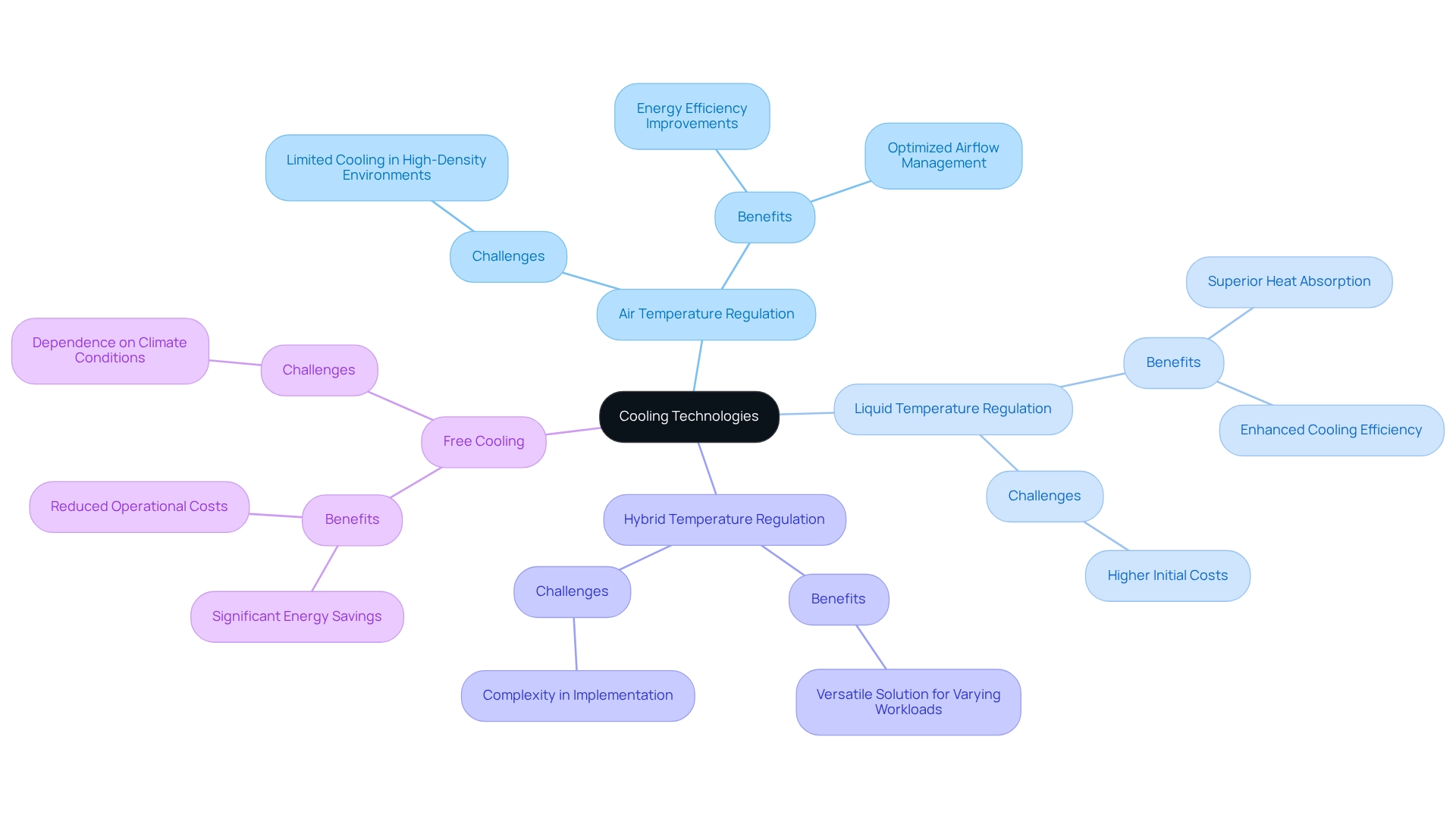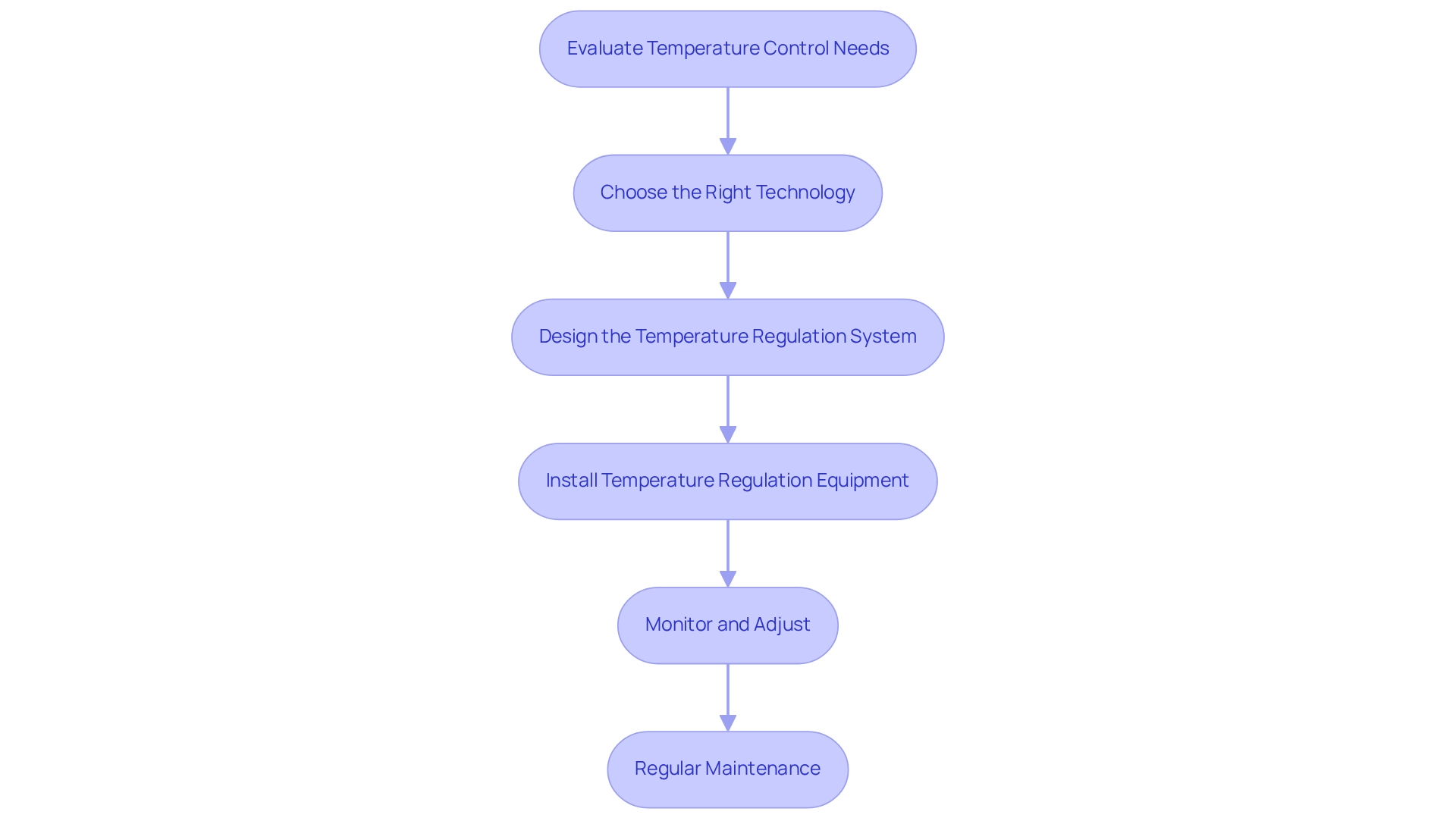Overview
The primary emphasis of this article is on the essential strategies and solutions for effective data center cooling, a critical factor in maintaining optimal temperatures and preventing equipment failure. It elucidates various cooling technologies, including air, liquid, and hybrid systems, while underscoring the significance of energy efficiency and operational reliability in temperature management. These elements are vital for enhancing performance and sustainability in data centers.
Introduction
At the core of every data center lies a significant challenge: the management of heat produced by the ever-increasing density of servers and networking equipment. As technology progresses and demands for data processing escalate, maintaining optimal operating temperatures becomes crucial to avert equipment failure and minimize costly downtime.
This article explores the fundamental concepts of data center cooling, examining the innovative solutions and technologies that are shaping the future of thermal management. From traditional air cooling methods to advanced liquid cooling systems, the landscape is evolving rapidly, driven by the imperatives of efficiency and sustainability.
As organizations endeavor to align their cooling strategies with industry demands, grasping these principles will empower data center managers to optimize performance while reducing environmental impact.
Explore the Fundamentals of Data Center Cooling
Due to the high density of servers and networking equipment, data centre cooling is essential as data centers represent significant sources of heat. Maintaining optimal temperatures for data centre cooling, typically between 70°F and 75°F (21°C to 24°C), is crucial for preventing equipment failure and minimizing downtime. Effective temperature control strategies are essential for data centre cooling to manage the excess heat generated by IT equipment. Key concepts include:
- Heat Generation: Servers and networking devices produce substantial heat, necessitating efficient cooling solutions.
- Heat Transfer: Heat dissipation occurs via conduction, convection, and radiation, each contributing significantly to efficiency in temperature reduction.
- Temperature Load Calculation: Precisely assessing the temperature requirements based on equipment specifications and environmental conditions is essential for efficient management.
As we look towards 2025, data centre cooling and the average operating temperatures for data centers remain a focal point, with industry leaders emphasizing the need for innovative temperature regulation technologies to address rising heat generation. Gagner-Toomey Associates distinguishes itself as a premier supplier of , featuring an extensive range of DC input tube axial fans and centrifugal blowers, available in sizes from 15 to 280mm and 15 to 225mm, respectively. These products are optimized for performance, efficiency, and low noise, with IP protection available in most models upon request. Their extensive portfolio includes standard and custom designs tailored for electronics and automotive applications, solidifying their position as a key player in the thermal management landscape.
Recent trends indicate a movement towards sophisticated temperature regulation methods for data centre cooling, such as liquid temperature management and AI-driven thermal control systems, which enhance efficiency and reduce energy consumption. As the information hub infrastructure market is projected to expand from $273.88 billion to $549.99 billion by 2032, understanding these refrigeration fundamentals will empower information hub managers to adopt efficient strategies that align with evolving industry requirements. Furthermore, revenue from generative AI in server facilities is anticipated to rise at a 58% CAGR from 2023 to 2028, highlighting the increasing significance of effective data centre cooling. As Toby Owen observed, “The real benefits of the cloud are slightly different than we originally predicted; they are less about pure cost efficiency, and more about speeding up time to market (aka agility).” This perspective highlights the necessity for CIOs to leverage cloud and hosting solutions to transform IT from a cost liability into a revenue generator. Additionally, Brightlio’s collaboration with top colocation providers illustrates the growing demand for customized colocation services, further emphasizing the importance of efficient temperature management in today’s server environment. For further information on Gagner-Toomey’s products, visit our website or find a distributor near you.
Examine Cooling Technologies: Methods and Mechanisms
Data facility temperature regulation technologies can be classified into various key techniques, each presenting unique benefits and challenges:
- Air Temperature Regulation: This prevalent approach employs Computer Room Air Conditioners (CRAC) and Computer Room Air Handlers (CRAH) to circulate cool air and effectively dissipate heat. Recent advancements in air temperature regulation technologies have prioritized enhancing energy efficiency and optimizing airflow management—crucial factors as information hubs evolve to support increased workloads.
- Liquid Temperature Regulation: Renowned for its superior heat absorption capabilities, liquid temperature regulation methods, including direct-to-chip methods and immersion techniques, are gaining traction, particularly in high-density environments. These methods significantly enhance data centre cooling efficiency, making them ideal for contemporary data centers that demand robust performance. For instance, the collaboration between Dell Technologies and Submer aims to deliver immersion-ready servers designed for high-performance tasks, showcasing the effectiveness of liquid temperature management. This partnership underscores the growing recognition of liquid temperature regulation’s advantages in effectively managing thermal loads.
- Hybrid Temperature Regulation: This technique integrates air and liquid methods to optimize efficiency and performance. By adapting to varying workloads and environmental conditions, hybrid systems provide a versatile solution that addresses diverse temperature regulation requirements.
- Free Cooling: By utilizing outside air or water for refrigeration, can substantially reduce energy consumption and operational costs. In regions like Finland, information hubs benefit from over 8,000 hours of free temperature regulation annually due to the arctic climate, highlighting the potential for significant energy savings. Furthermore, with Latin America leading in renewable energy for information centers—over 60% of power capacity sourced from renewables—natural ventilation can further enhance operational efficiency in these areas.
As the sector continues to evolve, the efficiency comparison between air and liquid temperature management remains a focal point. While air refrigeration is still commonly employed, liquid temperature regulation is increasingly recognized for its effectiveness in high-density facilities, offering substantial advantages in energy efficiency and thermal control. According to CBRE, revenue from generative AI facilities is projected to grow at a 58% compound annual growth rate from 2023 to 2028, emphasizing the escalating demand for effective data centre cooling to support this growth. Understanding these technologies is essential for engineers striving to implement the most efficient temperature regulation methods in their facilities.

Understand the Importance of Effective Cooling Strategies
Effective temperature control strategies are essential for data centre cooling, driven by several key factors:
- Energy Efficiency: Temperature management systems account for 30-50% of a data center’s total energy consumption. With rising energy costs in Europe, there is a marked shift towards energy-efficient liquid temperature regulation methods that promise significant savings. By implementing advanced data centre cooling solutions, operators can drastically reduce energy expenses and enhance Power Usage Effectiveness (PUE). Additionally, maintaining through data centre cooling is crucial for prolonging the lifespan of IT equipment. Data centre cooling through efficient temperature regulation reduces the frequency of replacements and repairs, ultimately leading to lower operational expenses. For instance, the ColdLogik RDHx technology from Legrand demonstrates how rear door heat exchanger technology can eliminate up to 200 kW per cabinet, promoting sustainable temperature regulation efficiency and operational savings while decreasing energy usage and CO2 emissions.
- Operational Reliability: Effective temperature management mitigates the risk of overheating, which can lead to system failures and costly downtime. This reliability is vital for businesses that depend on constant information availability, particularly in the context of data centre cooling. Robust uninterruptible power supply (UPS) systems are essential in ensuring that data centre cooling maintains uptime, underscoring the importance of temperature regulation in operational strategies. As information hubs increasingly focus on reducing their carbon footprint, efficient data centre cooling systems play a pivotal role in sustainability efforts. By decreasing energy consumption and incorporating renewable energy sources, these strategies contribute to a greener operational model. Legrand’s closed water loop system, for example, significantly minimizes water consumption, reducing water usage effectiveness (WUE) to zero, further enhancing its environmental credentials and supporting sustainability initiatives.
By prioritizing efficient temperature management strategies, facility operators can not only enhance performance and reduce costs but also align with broader sustainability objectives, ensuring a resilient and effective infrastructure.
Implement Cooling Solutions: A Step-by-Step Guide
Implementing efficient temperature control solutions in information centers necessitates a systematic approach that encompasses several essential steps:
- Evaluate Temperature Control Needs: Begin by assessing the current temperature management requirements, taking into account equipment load, facility layout, and environmental conditions. This assessment is crucial for understanding the specific demands of your data center.
- Choose the Right Technology: Based on the assessment results, select the most suitable temperature regulation technology—whether air, liquid, or hybrid. It is vital to consider future scalability needs to ensure the chosen solution can adapt to evolving demands. Notably, data centre cooling is increasingly important in managing liquid temperature regulation for emerging technologies within data centers.
- Design the Temperature Regulation System: Strategically plan the layout of temperature control units, airflow paths, and containment strategies, such as hot aisle/cold aisle configurations. This design phase is essential for enhancing temperature regulation efficiency and minimizing energy consumption. As highlighted, most passive temperature regulation solutions are based on the principle of airflow management, which is critical for effective data centre cooling strategies.
- Install Temperature Regulation Equipment: Adhere to manufacturer guidelines during installation to ensure proper placement and configuration of temperature regulation units. This step is essential for maximizing the efficiency of the refrigeration system.
- Monitor and Adjust: Implement advanced monitoring systems to continuously track temperature and humidity levels. Frequent modifications relying on real-time information will assist in sustaining ideal conditions and avoiding overheating.
- Regular Maintenance: Schedule routine upkeep for all temperature control equipment to ensure long-term reliability and efficiency. Proactive maintenance can significantly prolong the lifespan of refrigeration systems used in data centre cooling and enhance overall efficiency.
By adhering to these steps, facility managers can apply temperature control methods that not only enhance operational performance but also support sustainability initiatives. For instance, the recent partnership between Schneider Electric and Compass Datacenters underscores the significance of in optimizing supply chains and improving product delivery in the data center industry. Furthermore, the collaboration between Fujitsu and Microsoft, focused on assisting businesses in transitioning their workloads to the cloud, highlights the increasing trend of cloud migration and its effects on temperature management solutions. As the industry shifts towards more sustainable practices, understanding and implementing effective cooling strategies will be paramount.

Conclusion
The management of heat in data centers presents a critical challenge that directly influences operational efficiency, equipment longevity, and sustainability. As technology advances, a solid grasp of the fundamental concepts of data center cooling becomes essential. Key strategies, including air cooling, liquid cooling, and hybrid systems, each offer distinct advantages, enabling data center managers to select the most effective cooling solutions tailored to their specific requirements.
Implementing effective cooling strategies not only enhances energy efficiency but also significantly reduces operational costs and minimizes environmental impact. Recent trends indicate a shift towards liquid cooling and advanced thermal management technologies, reshaping the landscape and underscoring the necessity for organizations to adopt innovative solutions that align with industry demands. The growth projections for the data center infrastructure market, coupled with the increasing revenue from generative AI, highlight the urgent need for efficient cooling mechanisms.
In conclusion, prioritizing effective cooling solutions is vital for ensuring reliability, sustainability, and performance in data centers. By adopting a systematic approach to cooling management, data center operators can enhance their operational efficiency while playing a pivotal role in achieving broader sustainability goals. As the industry continues to evolve, embracing these cooling technologies will be essential for thriving in a competitive landscape and addressing the challenges of tomorrow.
Frequently Asked Questions
Why is cooling essential in data centers?
Cooling is essential in data centers because they contain a high density of servers and networking equipment that generate significant amounts of heat. Maintaining optimal temperatures, typically between 70°F and 75°F (21°C to 24°C), is crucial to prevent equipment failure and minimize downtime.
What are the key concepts related to data center cooling?
The key concepts related to data center cooling include heat generation from IT equipment, heat transfer methods (conduction, convection, and radiation), and temperature load calculation to assess temperature requirements based on equipment specifications and environmental conditions.
What innovations are being emphasized for data center cooling as we approach 2025?
As we approach 2025, there is an emphasis on innovative temperature regulation technologies such as liquid temperature management and AI-driven thermal control systems to enhance efficiency and reduce energy consumption in data centers.
What role does Gagner-Toomey Associates play in data center cooling?
Gagner-Toomey Associates is recognized as a premier supplier of innovative temperature control systems, offering a range of DC input tube axial fans and centrifugal blowers optimized for performance, efficiency, and low noise, with options for IP protection in most models.
How is the information hub infrastructure market projected to grow, and why is this relevant to data center cooling?
The information hub infrastructure market is projected to expand from $273.88 billion to $549.99 billion by 2032. This growth highlights the increasing importance of effective data center cooling as managers seek efficient strategies to meet evolving industry requirements.
What is the anticipated growth of revenue from generative AI in server facilities?
Revenue from generative AI in server facilities is anticipated to rise at a 58% compound annual growth rate (CAGR) from 2023 to 2028, underscoring the significance of effective data center cooling in supporting this growth.
What does Toby Owen suggest about the benefits of the cloud in relation to data centers?
Toby Owen suggests that the real benefits of the cloud are more about increasing agility and speeding up time to market rather than just cost efficiency, indicating a need for CIOs to leverage cloud and hosting solutions to transform IT into a revenue generator.
How does Brightlio’s collaboration with colocation providers relate to data center cooling?
Brightlio’s collaboration with top colocation providers illustrates the growing demand for customized colocation services, emphasizing the importance of efficient temperature management in today’s server environments.

